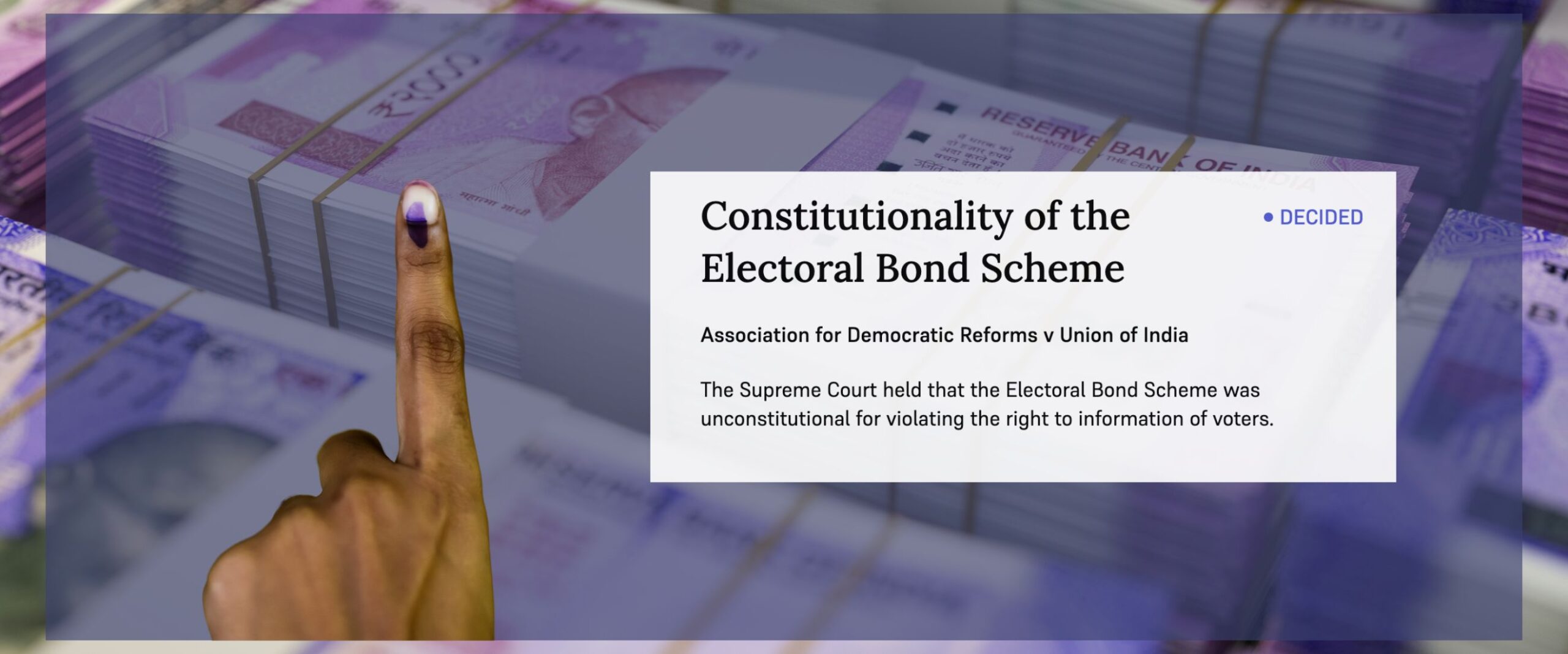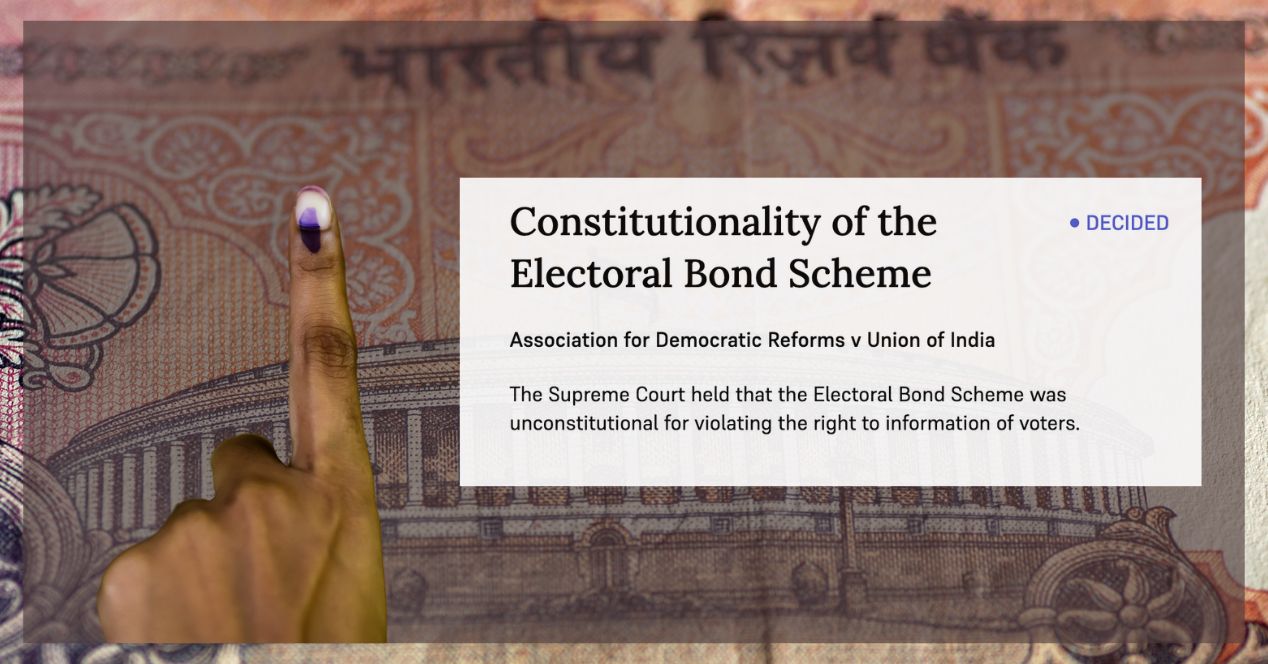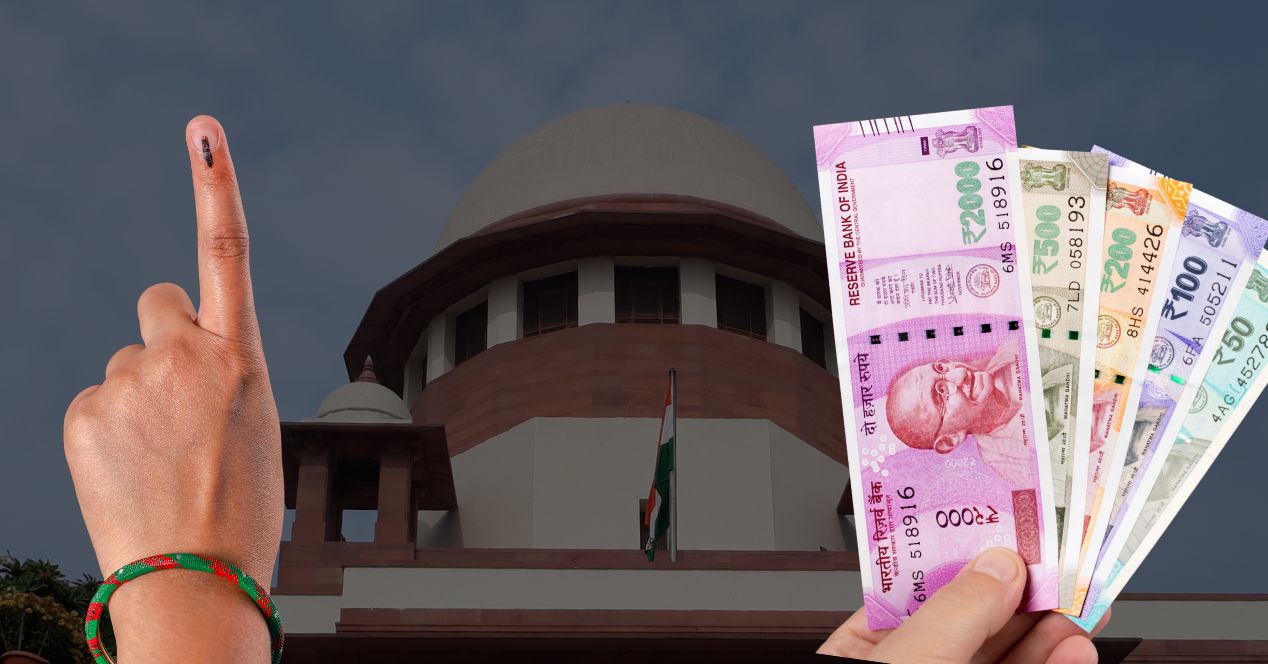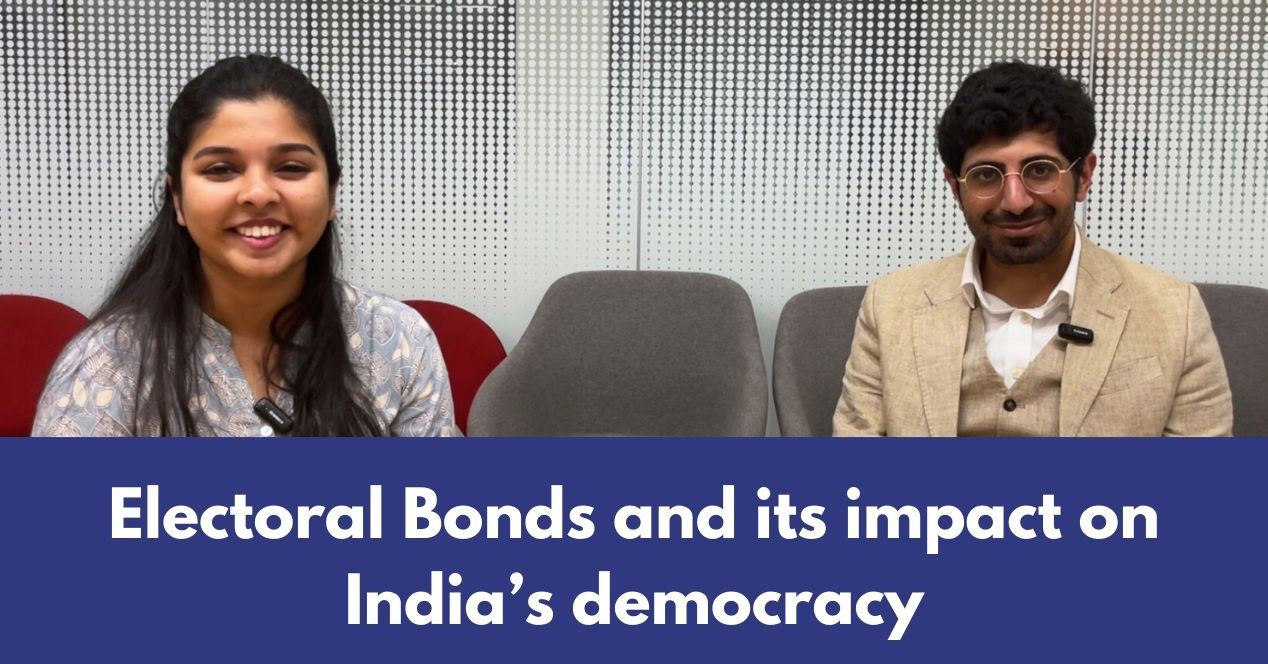Analysis
The making and unmaking of the Electoral Bond Scheme: Part 1
The Supreme Court’s judgement has validated the concerns expressed by various stakeholders during the planning stage of the Scheme.

This is the first part of our two-part feature on the Electoral Bond Scheme. Part 2 is here. You can access the case background and detailed hearing reports here.
On 7 January 2018, between birthday wishes and congratulatory posts, then Finance Minister Arun Jaitley posted a short status update on his Facebook wall. “Electoral bonds are key to evolve a clean political funding system in India” it said. He was following up a longer note titled “Why Electoral Bonds are Necessary” where he explained that the conventional practice of “anonymous or pseudonymous” political funding had created a situation of “unclean money coming from unidentifiable sources.”
When Jaitley proposed the Electoral Bond Scheme in the Lok Sabha in the 2017-18 Union Budget Speech, he had explained that it was a way to address donors’ “reluctance in donating by cheque or other transparent methods” and to protect them from having to “disclose their identity and entail adverse consequences.”
On 2 January 2018, just five days before Jaitley’s Facebook justification, the Union had issued a notification announcing the scheme. An Electoral Bond was like a promissory note. Except, it wouldn’t have the name of the donor or the donee. This money instrument offered a completely anonymous donation mechanism.
For some, even in those early days, the glossy picture of clean money in political and electoral funding seemed like a mirage. “What was really required—which is what we thought would happen—is the government saying that no amount of donation to any political party will be anonymous,” said transparency activist and social worker Anjali Bhardwaj. “Instead, the Scheme allowed political parties to receive any amount of donations through bonds and no one, including oversight institutions like the Election Commission of India, could know the source of this funding.”
Thirty phases of sale were completed in the lifespan of the Scheme. Bonds worth ₹16,518 crores were purchased. An RTI filed by transparency activist Commodore Lokesh Batra (Retd.) revealed that ₹571 crore worth of bonds were sold in a 10-day window in January 2024 alone, the last phase that took place before the 2024 General Election starting in April.
The first challenge against the Scheme had been filed in the Supreme Court in September 2017, months before the Scheme was notified in January 2018 by the NGO Association of Democratic Reforms. The matter moved at the usual glacial pace for several years, until the petitioners approached the Court in October 2023, asking for it to be decided before the 2024 General Election. Finally, a Constitution Bench heard arguments over three days in October and November last year. Then, on 15 February 2024, upending many expectations, the Bench declared the Scheme unconstitutional.
The Court’s reasoning
The Court upheld the voter’s right to information over the donor’s right to privacy. In law, there is “no constitutional hierarchy between the right to information and the right to informational privacy of political affiliation,” the judgement said. However, the Bench saw that “the scheme only grants de jure and not de facto confidentiality vis-à-vis the political party.” The Scheme, CJI Chandrachud wrote, was only confidential to the extent that it deprived voter’s right to know, and not political parties’ access to this information.
The Supreme Court’s decision endorsed the idea of ‘one person, one vote’.
It held that “unlimited contribution by companies to political parties is antithetical to free and fair elections because it allows certain persons/companies to wield their clout and resources to influence policy making.”
The Court also tested the constitutionality of unlimited corporate funding. It rejected the Union’s arguments that the Scheme sought to offer a donations mechanism to corporations so they wouldn’t have to resort to using shell corporations to make anonymous donations. It found that there was “no justification” for doing away with the cap on company donations, considering that its purpose was to “deter shell companies from making political contributions.”
Then, there was the mini-saga stemming from the Court’s directions to the State Bank of India to ensure that all details of the bonds were brought into the public domain by 6 March 2024. The SBI asked for over three months’ time, reasoning that it would take some time to match donor and redeemer data, which was in two separate silos.
The Court did not budge. In a hearing on 11 March, the CJI said “There should be a degree of candour on the part of the State Bank of India,” and ordered it to submit all the data as is by the end of business hours the next day. By 14 March, the information was in the public domain.
On 15 March, the Court noted that the data submitted by the SBI was incomplete, and lacked details of the alphanumeric entries on each bond. They ordered SBI to submit “all details.” This missing piece would make it possible to work out which donor had donated to which party. By the end of 21 March, this data was released.
Since the first stage of public disclosure, several journalistic outlets have engaged in the rigorous task of putting two and two together. They found that the concerns around quid pro quos were well-founded. The list of donors included companies that won tenders for big-ticket infrastructure projects and some that had been in trouble with watchdogs like the Enforcement Directorate and Comptroller and Auditor General of India. The list also included some companies accused of environmental violations.
Quid pro quo and other concerns have hung around the Scheme since the days of its somewhat murky establishment.
For a programme that promised to make election funding more transparent, the way it was pushed through the echelons of government and bureaucracy didn’t inspire much confidence.
In the first part of this two-part feature on the Electoral Bond Scheme, we go back to how the Scheme was put together in the first place.
The beginning
Five amendments, introduced through the 2016 and 2017 Finance Acts, created the legal framework for the Electoral Bond Scheme.
The first step, taken in 2016, was an amendment to the Foreign Contribution Regulation Act, 2010 (FCRA). It allowed foreign companies with subsidiaries in India to donate to political parties.
In 2017, an amendment to the Reserve Bank of India Act, 1934 allowed the Union government to “authorise any scheduled bank to issue electoral bond[s].” An amendment to the Income Tax Act, 1961 exempted political parties from keeping a detailed record of contributions received through electoral bonds. Changes made to the Representation of the People Act, 1951 exempted political parties from publishing contributions received through electoral bonds in “Contribution Reports.” Finally, changes to the Companies Act, 2013 removed the upper limit on how much a company could donate to a political party, and their obligations to disclose the breakup of contributions made to different parties.
This framework effectively allowed companies making losses, shell companies and foreign companies to secretly donate to parties. It also facilitated kickbacks and quid pro quo deals between political parties and companies.
Nitin Sethi, journalist at the Reporters Collective who wrote a multi-part investigative report on the Electoral Bonds Scheme, told me that it initially seemed like everyone was “okay with” the Scheme. He said that even among reporters who had long studied corruption and political financing, there were very few who saw anything unusual.
By 2019, however, RTIs filed by Commodore Batra, Bhardwaj and other transparency activists had established that the Scheme was introduced despite clear warnings issued by the Reserve Bank of India (RBI), the Election Commission of India (ECI) and various opposition parties.
The file without a name
With the help of the RTI responses received by Batra, Sethi deduced that there was no name attached to the internal file that introduced the idea for the Scheme. Typically, Sethi explained, a new policy idea is proposed by someone within the bureaucratic apparatus or a private citizen. When the idea is suggested by a government officer, a file is created.
“A file was suddenly started at the level of a joint secretary,” he said. The skeleton of the idea was in an unmarked A4 sheet that Commodore Batra had accessed through the RTI route. Sethi had written that it was “unlike most memos prepared by the Indian bureaucracy.” When I asked him if he knew who it was from, he said: “A couple of us have a sense of who the author was, but going by journalistic standards of evidence, we can’t prove it.”
The RBI’s warning
On 28 January 2017, the Department of Economic Affairs wrote to Rama Subramaniam Gandhi, the RBI Deputy Governor, “requesting early comments” on the amendments to the RBI Act.
The RBI responded within two days, warning the Finance Ministry that the Bonds could “undermine faith in banknotes.” Chief General Manager P. Vijay Kumar wrote that though the Scheme required the submission of KYC documents, it was evident that “the original buyer of the instrument need not be the actual contributor to…[the] party.” The RBI noted that “the intended purpose of transparency may not be achievable” and that the “principles and the spirit of the Prevention of Money Laundering Act, 2002 (will get) affected.”
The RBI also unequivocally said that “there is no special need for, or advantage by, the creation of an Electoral Bearer Bond.” Echoing the rationale that the Supreme Court would later use to quash the Scheme, the RBI reminded the Finance Ministry that “existing banking instruments like cheques, drafts, digital modes” can equally achieve the goal of offering a formal and traceable mechanism for donations.
Revenue Secretary Hasmukh Adhia dismissed the RBI’s concerns on the same day. “The RBI has not understood the proposed mechanism” he said in an internal note addressed to the Secretary for Economic Affairs and Arun Jaitley. “The fear of such bearer instrument being used as currency is totally unfounded.” And lastly, he wrote, “this advice has come quite late at a time when the Finance Bill is already printed.” Jaitely reportedly signed off on the note immediately. “You could see how quickly it was forced through,” Sethi said.
Around September 2017, the RBI wrote to Jaitely again. They recommended that RBI be the sole issuer of the bond, and that all bonds be bought and sold only digitally. In his memoir, Subhash Chandra Garg, former finance secretary, explained that this would “kill the most important feature that Arun Jaitely wanted to build in,” which was anonymity. Garg was Secretary of Economic Affairs while these discussions on the Scheme were underway.
Garg recalls that Urijit Patel, then Governor of the RBI, had approached the Committee of Central Board (CCB), an internal group that assists the RBI’s Central Board of Directors, and had several meetings to discuss the features of a digital bond for political funding.
Garg singled out a line he saw in the minutes of a CCB meeting: “If the government decides to issue electoral bonds in script though SBI (State Bank of India), the Bank (RBI) should let it be.” In Garg’s telling, these minutes are what the Finance Ministry relied on to construe the consent of the RBI.
In effect, the central bank, under Patel, never expressly submitted its final comments or consent to the Scheme.
The Law Ministry’s change of heart
The Scheme then needed the Law Ministry’s approval as well. “We had expected the ministry to vet the proposed notification in a routine manner, the way hundreds of other notifications are cleared,” Garg wrote. In November 2017, the Scheme was sent for the Law Ministry’s approval.
The Law Ministry recommended some alterations. Garg recalled that it had questioned the 1 percent vote-share cut-off imposed on political parties to be eligible to receive bonds. In early December 2017, the Law Ministry recommended that the limit be increased to 6 percent. This would mean that far too few parties would be eligible for the Scheme.
According to Garg, the Law Ministry “made an about turn” later that month, after the Department of Economic Affairs countered that imposing a cut-off “may not be in sync” with Section 29B of Representation of People Act (ROPA) which permits “every political party” to receive corporate funding. Garg notes that the Department of Economic Affairs managed to convince the Law Ministry that the matter came under its purview because it was “a policy matter and not a legal issue.”
The Law Ministry was also required to assess whether the amendments could be brought in as a Money Bill, which would mean the Rajya Sabha would not have the power to amend or reject it. In their petition, the Association of Democratic Reforms had argued that the 2016 and 2017 Finance Acts had to be treated as ordinary draft statutes since they legislated on matters beyond the features delineated in the Money Bill provision of the Constitution.
The Law Ministry, on its part, seemed to go out of its way to accommodate the amendment to the Companies Act as a Money Bill. Though it saw that the amendments did not fall under Article 110(1) “in a strict sense,” they opined that the changes “may be made” as a Money Bill since they concerned the “IT Act and tax revenue of the government.” Dr. R.J.R. Kasibhatla, Deputy Legal Advisor, also wrote that “regular legislative practice and procedure” should be adopted “next time.” The consequence of this was that the Scheme was never debated in the Rajya Sabha.
A ‘generally supportive’ EC, a ‘continuing to object’ commissioner
On 26 May 2017, as deliberations on framing the finer points of the Scheme were underway, the Election Commission of India wrote to the Ministry of Law and Justice. They warned that the amendments to the IT Act, RoPA and Companies Act “will have a serious impact on transparency.” They acknowledged the possibility of “shell companies being set up for the sole purpose of making donations to political parties.”
The report was shared with the Finance Ministry on 3 July 2017, which, in Sethi’s words, “simply pretended it had never heard from the Commission.” In his memoir, Garg writes that Jaitely had advised him to “meet the full EC (all election commissioners) to explain the scheme and secure its concurrence, if possible.”
The appointment of Sunil Arora as election commissioner was “expected to bring balance to the approach of the EC.”
When Garg met them in September 2017, the committee included Achal Kumar Jyoti (the Chief), Om Prakash Rawat and Sunil Arora. Garg describes Jyoti and Arora as “generally supportive” even as Rawat “continued to object.”
Documents unearthed by the RTIs show that Garg told Jaitley that the ECI were “reasonably satisfied” but Jyoti had raised three issues with the Scheme: individual candidates and small parties could not avail the benefits of the scheme; the amendments to the RoPA and the IT Act were inconsistent; political parties were not being mandated to furnish details of the aggregate amount of bonds redeemed in each denomination.
Garg recalls that the ECI was not heard from again after this meeting—until its affidavit submitted to the Supreme Court in March 2019 objecting to the Scheme. Here, the ECI stated that it will not “take any contentious issues” or “join any submissions on merits,” as they are “matters between contending parties.” It did, however, clarify the position of law on the validity of the Scheme, and stated that the framework “will have serious repercussions/impact on the transparency aspect of political finance/funding of political parties.”
In an interview on the judgement, Advocate Shadan Farasat who represented the Communist Party of India (Marxist), stated that the ECI’s refusal to take a position was a “reflection on the continuous change we have been seeing in the nature of the ECI’s own independence.”
Weak opposition from Opposition
Opposition parties, who also stood to gain from the system of anonymous donations, only raised objections to the Scheme in the initial stages. The Finance Minister had written to seven national and 49 state parties, seeking suggestions.
The All India Congress Committee called it a “completely opaque mechanism”, noting that only the government will have access to the names of the donors and donees. The Bahujan Samaj Party requested a draft proposal before “giving effective and proper suggestions.” The Communist Party of India (CPI) said that it “fail(ed) to understand the need for such a retrograde step.”
Support came from BJP’s then ally, the Shiromani Akali Dal (SAD), which called it a “landmark step” towards transparency. However, even SAD felt that it would be “more ethical” to only allow profit-making companies to donate.
Adhia, the Revenue Secretary, wrote to the Secretary of the Department of Economic Affairs saying that “no other response had been received till date” apart from the Congress and BSP. Both parties had asked for a draft of the scheme, he said, and requested the DEA to “initiate necessary steps for formulation of the scheme.”
Over time, however, other than the CPI, even the political parties which had raised concerns became complicit. “Later on, all the political parties realised it was in their favour,” Major General Anil Verma from the ADR said. “The point is that this electoral bond animal favours the ruling party. Wherever, and in whichever state.”
Deliberations, which went on between several institutions, departments and high government officials ensued for a few months. It was only when details emerged from the RTIs that it became clear how briskly and conveniently it was all managed within the bureaucratic and administrative apparatus. Recently, Sethi evocatively described the making of the framework as “silent ball pens and correspondence in small print.”
The noise began with ADR’s petition in the Supreme Court in September 2017. Soon after, the RTIs and the reporting of journalists like Sethi revealed the bull-headedness with which the government had pushed the Scheme through. Part 2 of this feature tells the story of how the Supreme Court became centre stage in the battle between the voter’s right to know and the donor’s right to secrecy.




